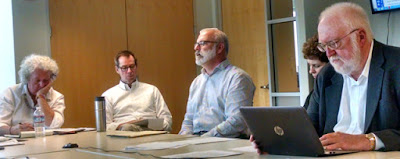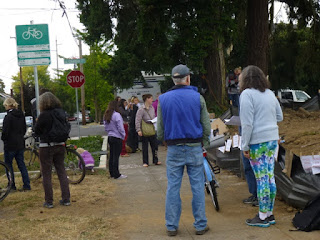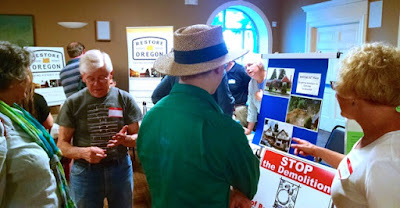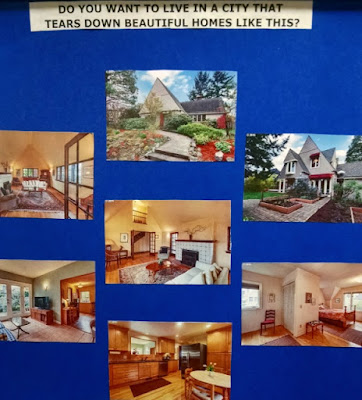 |
| Local news station KGW ran this chart on home demos in Portland, showing the increasing destruction from 2010 (data for 2015 remains incomplete). Casual readers of this graphic can see that there were twice as many demolitions last year than in 2010 and 2011. Note: The data does not capture the "bulldozer remodels," also prevalent and on the increase. More stats here. |
With a bit of googling (and I'm sure Carder has more resources at her disposal, because DRAC works under the aegis of the Bureau of Development Services), I found the above chart showing the numbers of Portland's demolitions, with the year 2015 not fully reported yet. Bear in mind these "demolitions" don't include the "remodels" that have the effect of demolition.
Carder is the rep for the "neighborhood coalition land use committees" on DRAC. With nearly half of the city's neighborhood associations on board with the UNR resolution to curb demolitions, how is she forming her opinions?
Luckily, Peggy Moretti of Restore Oregon piped up to say, "We do believe it is an epidemic just by the escalating numbers that we have tracked." Further, she noted: "The demolition tax aligns with [Portland's] sustainability goals. It should hurt to dump that much in the landfill." The mill in Newberg that used to burn our old-growth homes closed last month; now all that classic Portland architecture and history will fill our landfill. Portlanders love to recycle, but the short-term investor-developers plying our neighborhoods don't.
If you watch the City Council proceedings, don't miss Paul Grove of the Home Builders Association (HBA), thoroughly stumped by questioning of Commissioner Nick Fish at 2:18. He later showed up—or a doppelgänger anyway—at the Dec. 1 meeting of the Residential Infill Project stakeholder advisory committee (RIP SAC), where he sighed and writhed on the sidelines when not poking his HBA brethren on the committee. He left at the half, presumably disgusted by the threat to business as usual.
It's time to show up and speak up
Speaking of the city's Residential Infill Project, its members soldier on to create improved guidelines for new construction. If demolitions continue to occur at such an increasing rate (and again, the chart above shows so), it may be better to shape what comes in their wake, and therefore disincentivize the destruction in the first place.
 |
| Hillary Dames of South Burlingame gets vocal and visual at the Dec. 1 meeting of the Residential Infill Project. Join her and others demanding improvements in new development. |
At the Dec. 1 meeting, during the 10-minute public comment period that followed the city's 2-hour comment period, activists from South Burlingame again made their points. Afterward, a member of the committee intimated that these problems might be unique to South Burlingame and not experienced by neighborhoods throughout the city. Residents of other neighborhoods used to sit and nod at the analysis and comments out of South Burlingame, feeling no need to stand up and reiterate, but that must change.
The committee needs to hear from every aggrieved neighbor and neighborhood to believe problems with new development occur citywide.
 |
| On Northeast Alameda, a vintage home (below) becomes an eyesore and a safety hazard (above) courtesy Everett Custom Homes. |
Wasting Portland for what?
As proof of how little the out-of-town outfits value the legacy, history, and quality of Portland's classic built environment, Everett Custom Homes now erases housing just to put the land up for sale. This in a city that recently declared a "housing emergency."
As elsewhere in other neighborhoods, Everett took down this home on Northeast Alameda, leaving a trash-ridden plot of land with an open trench next to the sidewalk.
Recently City Council heard from a man who because of his sight disability can't easily navigate construction sites or sidewalk closures. As with the continued lack of hazmat control at demo sites, lack of enforcement of building codes (this even came up at RIP SAC where city staff noticed their slide show was full of non-code compliant projects and yet no corrections occurred), and disregard for elemental safety precautions, one wonders who's calling the shots and who among our city leaders can and will stand up for Portland residents.
The last word on the demo tax
Maybe you're still wondering about that demo tax. Wonder no more. After its last presentation at City Hall in November, the mayor himself seemed to give up on it. Why else would he give the idea to DRAC for fine-tuning? These are the folks who can't make sense of a bar chart showing a rising number of demolitions, and who can't acknowledge the demolition epidemic first announced in summer 2014 by the city's own Historic Landmarks Commission.
Then we learned the demo tax is itself demolished. This means that more than ever, we need the demo moratorium to hit the pause button, do some fresh thinking, and ensure priorities align with action. We need more voices at the RIP SAC. And we need people on the front lines to protect the public from life-changing health hazards (read on).
Something's hard at work in your city, but it's the dark side and hard to see. This isn't Star Wars, but UNR is proud to be part of the Earth-bound resistance movement. We want to keep what's good in Portland, and build better.
Public safety's on us
Early next year, UNR, the Beaumont-Wilshire Neighborhood Association, and the Lead Safe America Foundation team up to screen a film on lead poisoning and to recruit activists who will help neighbors, especially kids, avoid exposure to hazardous materials during demolitions.
With demos spiking as they are (again, see graphic at top of this post), is this avoidable fallout reason why Johnny and Jane can't read? Could it be a contributing factor in Portland Public Schools' abysmal graduation rate? Come to the Hollywood Theatre on Feb. 29 to learn more and be the change you wish to see. Check the blog banner at top for details as we cement them.
Thank you to Central Northeast Neighbors for the grant that makes this effort possible.
Here's to a happy, healthy, and safer 2016!














































